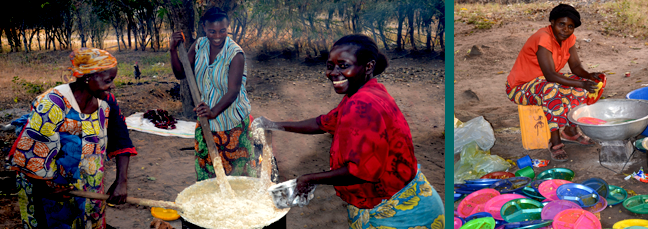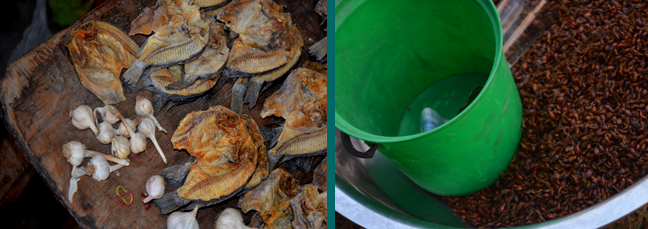There certainly is a difference when you
travel by yourself compared to traveling with a group of
Americans. I ate a whole lot more Western food on this trip than
usual. A chef from a restaurant in Lubumbashi was flown in to cook
for our group in Kamina. But, one Congolese staple was served for
many lunches or dinners. That was bukari. Similar food is
served all around Africa. In Zambia, it is nshima. It's
called pap in South Africa and fufu in West Africa.
Bakari didn't come as any surprise to me. Having lived and traveled in southern Africa, I'm very familiar with what Africans do with corn meal. However, anything and everything they do must be done with white corn meal. Yellow corn, and any corn meal associated with it, is only fit for animals.
Okay, here's how bukari is served to a bunch of tourists. It looks like a ball of mashed potatoes about the size of a tennis ball. I'm told that people who grow up on this diet might like to eat four, five, or even six of these. Almost everyone in my group of Americans opted for about half a ball (or less) of corn meal.
Now, anyone who knows anything about health will tell you that you need to wash your hands before a meal. This is even more important to remember if you plan to eat your bukari in traditional African style. You take your tennis ball and pinch off about a marble size of the meal. Roll it up with three fingers and then squish it flat. (It's okay if you need four fingers.) You now have an edible eating utensil in your hand. Pinch a little bit of spinach and savor the whole moment. Traditionally, you share a communal bowl with your friends and bond over a true African meal. Now, I must be truthful. I never saw one member of my little group do this. Everyone except me reached for a fork.

Bakari didn't come as any surprise to me. Having lived and traveled in southern Africa, I'm very familiar with what Africans do with corn meal. However, anything and everything they do must be done with white corn meal. Yellow corn, and any corn meal associated with it, is only fit for animals.
Okay, here's how bukari is served to a bunch of tourists. It looks like a ball of mashed potatoes about the size of a tennis ball. I'm told that people who grow up on this diet might like to eat four, five, or even six of these. Almost everyone in my group of Americans opted for about half a ball (or less) of corn meal.
Now, anyone who knows anything about health will tell you that you need to wash your hands before a meal. This is even more important to remember if you plan to eat your bukari in traditional African style. You take your tennis ball and pinch off about a marble size of the meal. Roll it up with three fingers and then squish it flat. (It's okay if you need four fingers.) You now have an edible eating utensil in your hand. Pinch a little bit of spinach and savor the whole moment. Traditionally, you share a communal bowl with your friends and bond over a true African meal. Now, I must be truthful. I never saw one member of my little group do this. Everyone except me reached for a fork.

Cooking
bukari for the masses and so many dishes!
Now, it's one thing to serve bukari to a
group of Americans, but it was a totally different situation when we ate
with a group of Congolese. And, I have to confess, I was shocked.
Forget about tennis balls! The servings were the size of
grapefruit! Nobody pinched off anything close to marble size
pieces. They were much closer to ping pong balls. It
appeared that everyone cleaned their plate, but there were no second
"grapefruits" for anyone.
Bukari is as flexible as rice. You
can eat it with anything. We had it served with chicken and
vegetable dishes as well as cassava leaves. However, the most
common dish that was served was spinach. I have to say, it was
delicious every way I tried it. And, if you want to eat it like an
African, you must add pili-pili. I didn't stutter. Those two
syllables are repeated, but many tasters don't want to have a repeat
tasting. It is a salsa made out of fire. It's truly hard to
imagine anything hotter. So, if you don't do hot, you probably
won't want to do pili-pili. And if you do try it, you probably
will never do it again. Fortunately for me, it was a taste that
brought me back to Peace Corps in Liberia. The hotter the recipe
the better! But, I will confess, the first three months I was in
Liberia, I cried almost every time I ate. The food was that hot!
Now if you want to go through the whole process of making bukari, I'm including a recipe. However, when I lived in Liberia, I was given a shortcut recipe that is supposed to work if you'd rather have an instant source. I promise you that I've never tried it no matter how easy it is. Mix one package of instant mashed potatoes with tapioca pudding. It's that simple and equally unimaginable!

Now if you want to go through the whole process of making bukari, I'm including a recipe. However, when I lived in Liberia, I was given a shortcut recipe that is supposed to work if you'd rather have an instant source. I promise you that I've never tried it no matter how easy it is. Mix one package of instant mashed potatoes with tapioca pudding. It's that simple and equally unimaginable!

Bukari
"grapefruit balls" with greens and fish heads
Bukari
Kamina, Democratic Republic of the Congo
Kamina, Democratic Republic of the Congo
Ingredients:
| 1 cup cold water 3 cups hot water |
2 to 3 cups corn meal |
Now this recipe is not anything like what I actually saw during preparation in the Democratic Republic of the Congo. I saw bukari prepared in cauldrons that you would expect witches to use, creating vast amounts of the corn meal to feed large crowds. But, unless you plan to create hundreds of bukari balls to feed the masses, this recipe will do.
So, if you can't even boil water, it's
time to stop reading the recipe. If you can, boil three cups of
water in a saucepan. Taking some meal, and no recipe said how much
"some" actually is, make a paste with some meal and the cup of cold
water. Then, mix your paste (a really good word to describe this
mix) into the hot water.
Stir the mix up until it thickens up into a porridge. Put a lid over the saucepan and simmer it for fifteen minutes. Then, lower the heat.
Remove the lid from the saucepan and slowly add in the rest of the corn meal. Stir the mixture to flatten any lumps of corn meal. Now depending on where you are in Africa, people want their corn meal ranging from thin to thick. But, if you are cooking up bukari, you want to boil the water away so it's thick enough to serve up as a ball. When the mixture solidifies into one big ball, you are ready to prepare your individual serving balls. And, you have to consider who you are serving the bukari to. Tennis ball size? Grapefruit size? It's all up to your hungry guests.
I asked people in my group who cooked how the spinach was prepared. (It was easier than communicating with people speaking Swahili.) However, when Gene (one of the imported Buckeyes) started his explanation, he spoke to me as if I knew how to cook and understood what he said. Remedial lessons began and he explained the spinach dish.
Stir the mix up until it thickens up into a porridge. Put a lid over the saucepan and simmer it for fifteen minutes. Then, lower the heat.
Remove the lid from the saucepan and slowly add in the rest of the corn meal. Stir the mixture to flatten any lumps of corn meal. Now depending on where you are in Africa, people want their corn meal ranging from thin to thick. But, if you are cooking up bukari, you want to boil the water away so it's thick enough to serve up as a ball. When the mixture solidifies into one big ball, you are ready to prepare your individual serving balls. And, you have to consider who you are serving the bukari to. Tennis ball size? Grapefruit size? It's all up to your hungry guests.
I asked people in my group who cooked how the spinach was prepared. (It was easier than communicating with people speaking Swahili.) However, when Gene (one of the imported Buckeyes) started his explanation, he spoke to me as if I knew how to cook and understood what he said. Remedial lessons began and he explained the spinach dish.

Bukari
"tennis balls" with spinach and pili-pili
Gene's
Spinach
Kamina, the Democratic Republic of the Congo by way of Cincinnati
Kamina, the Democratic Republic of the Congo by way of Cincinnati
Ingredients:
| 1 bag of spinach 2 tablespoons of butter |
Half a clove of garlic One quarter of an onion |
The first thing Gene told me was to take a soufflé pan. A what? You've got to be kidding me in my kitchen! I didn't even know what that was! However, with remediation, it was explained that it was a small skillet that needs a lid. I understand that and even have one in my kitchen.
Plop everything in the skillet. There isn't a lot of everything to this recipe. However, if your bag of spinach is too large, you have a couple of options. Double all the other ingredients or only use half the bag. Maybe this will make more sense to you after you see how the spinach boils down to almost nothing . . . or so I'm told. Anyway, toss in the butter and a tablespoon of water. Now, sauté your ingredients over medium heat in your soufflé pan (or skillet in remedial English) with the top on.
Sauté the greens until they change color. It's nothing dramatic. They are still green; they just turn a darker green. Now at this point, too many cooks jumped into the conversation. And, you know what too many cooks do. When do you take the spinach off the flame? Do you want your greens tender or mushy? Remember, they continue to cook after you remove them from the heat! Personally, I'm not too worried. If they are successfully cooked in any way, shape, or form, I'm going to be happy in the kitchen.
Plop a portion of the spinach by your bukari and don't forget the pili-pili!
